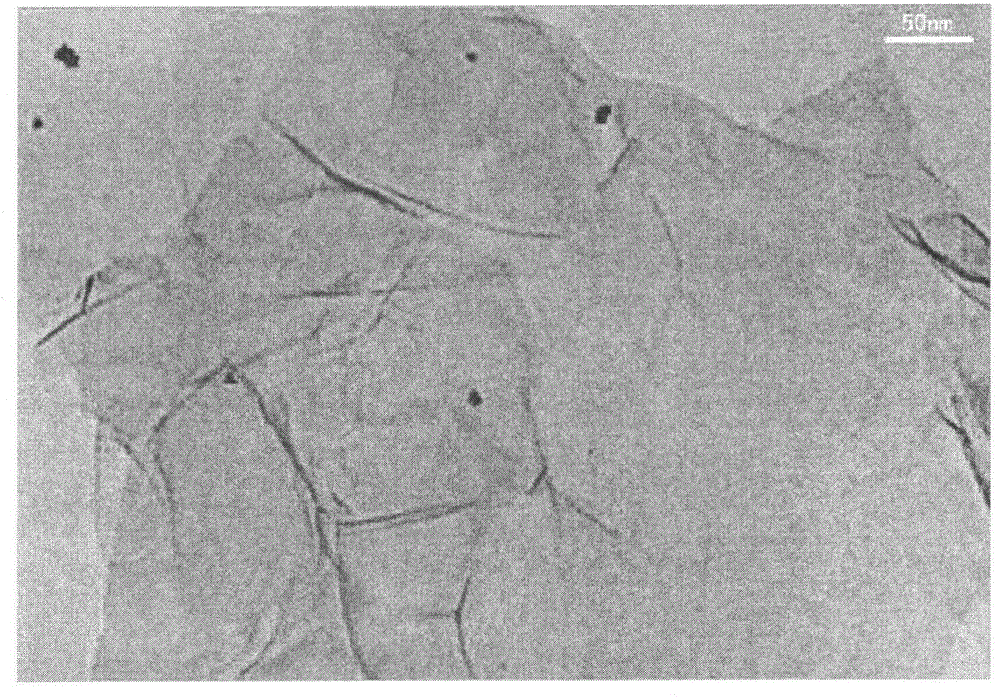Production method of anti-overlapping thin-layer graphene
A thin-layer graphene and production method technology, applied in the field of material chemistry, can solve problems such as difficult thin-layer graphene sheets, and achieve the effects of small environmental impact, simple production process, and small damage
- Summary
- Abstract
- Description
- Claims
- Application Information
AI Technical Summary
Problems solved by technology
Method used
Image
Examples
Embodiment 1
[0028] Get 400 grams of dried expanded graphite powder, add the vertical stirring ball mill, start the feeding pump and inject the chlorosulfonic acid of 12000ml. Then add 40 grams of superconducting carbon black, fill with 5 kilograms of balls, and mill for 10 hours. After ball milling, press and filter with a nitrogen pressure of 1.0 Mpa to reclaim excess superacid for recycling. Into the obtained filter cake, deionized water was carefully and slowly injected to decompose the remaining superacid, press-filtered and washed several times, and vacuum-dried overnight at 80°C to obtain a dry powder. Accompanying drawing is the thin-layer graphene transmission electron micrograph that embodiment 1 produces. In the produced powder, graphene sheets with a thickness below 10nm account for more than 50% of the total graphite sheets, and obviously contain a large number of thin-layer graphene, and the number of layers is between a single layer and 20 layers.
[0029] Get 100 grams of ...
Embodiment 2
[0031] Get 20 grams of dried 800 mesh natural flake graphite, add it into a horizontal sand mill, and then add 100 grams of pigment carbon black. Start the feeding pump to inject 3000ml of fluorosulfonic acid, and the sanding time is 8 hours. After grinding, press and filter with 0.8Mpa nitrogen pressure to recover excess super acid for recycling. Into the resulting filter cake, carefully and slowly inject NaOH aqueous solution to decompose the remaining superacid, press filter and wash several times, and vacuum dry overnight at 100°C to obtain a dry powder. In the produced powder, graphene sheets with a thickness below 10nm account for more than 50% of the total graphite sheets, and obviously contain a large number of thin-layer graphene, and the number of layers is between a single layer and 20 layers.
Embodiment 3
[0033] Get 10 grams of dried 300-mesh expandable graphite powder, add it to a high-energy planetary ball mill, and add 5 grams of fumed silica at the same time, then inject 50 ml of oleum, and fill the ball mill tank with nitrogen gas. In order to prevent the heat generated during the milling process from increasing the temperature in the milling tank, stop the machine for cooling every half an hour to ensure that the temperature in the mill does not exceed 60°C, and the milling time is 24 hours. After ball milling, the obtained mixture is moved into a quartz boat, which is pushed into a quartz tube vacuum furnace, which is connected to a water ring vacuum pump, which uses alkaline solution as a circulating water source. Turn on the water ring vacuum pump, and at the same time gradually increase the temperature to 900°C, cool down and take out the quartz boat to obtain a dry powder. In the produced powder, graphene sheets with a thickness below 10nm account for more than 50% o...
PUM
| Property | Measurement | Unit |
|---|---|---|
| Volume resistivity | aaaaa | aaaaa |
| Thickness | aaaaa | aaaaa |
| Thickness | aaaaa | aaaaa |
Abstract
Description
Claims
Application Information
 Login to View More
Login to View More - Generate Ideas
- Intellectual Property
- Life Sciences
- Materials
- Tech Scout
- Unparalleled Data Quality
- Higher Quality Content
- 60% Fewer Hallucinations
Browse by: Latest US Patents, China's latest patents, Technical Efficacy Thesaurus, Application Domain, Technology Topic, Popular Technical Reports.
© 2025 PatSnap. All rights reserved.Legal|Privacy policy|Modern Slavery Act Transparency Statement|Sitemap|About US| Contact US: help@patsnap.com

